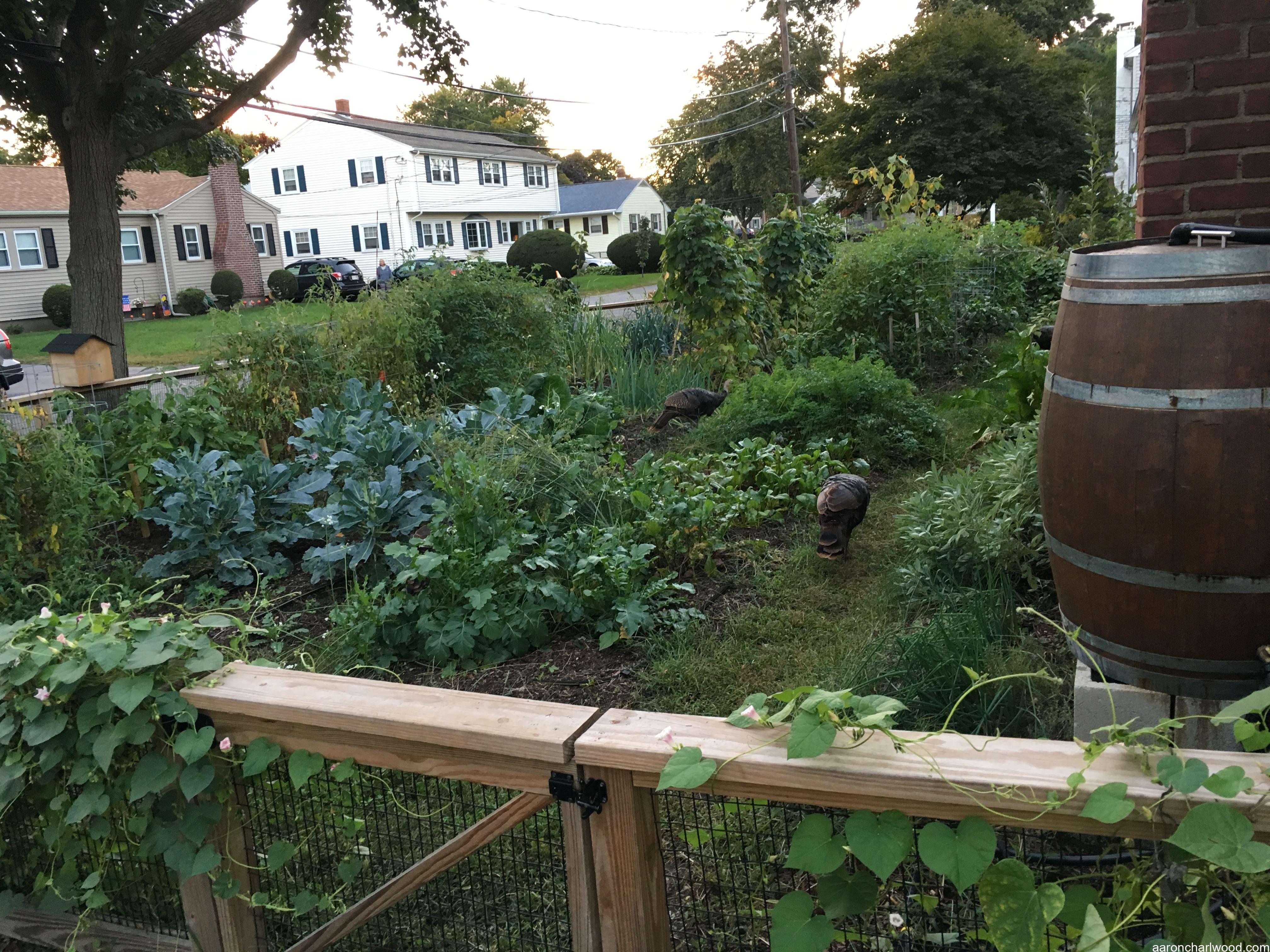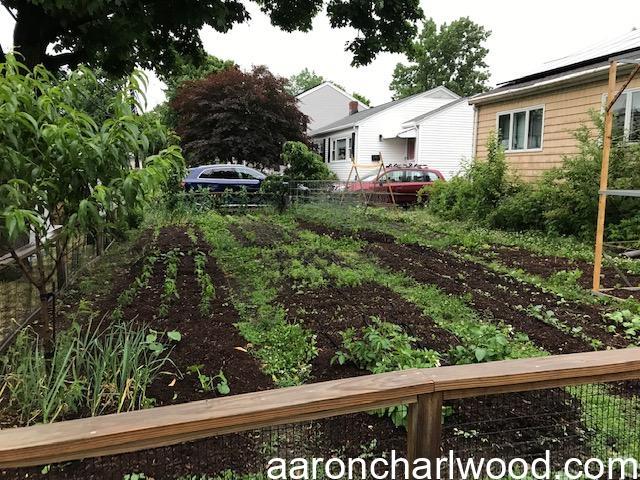
I started this garden in 2015 on what was formerly our front lawn. Every year, it’s been improved and expanded; here’s a chronicle of its progress.




I originally created two 4’x20′ beds by layering cardboard, loam, compost, and newspaper directly on top of the lawn. Pictured above are the two original beds, a newly planted cherry tree, both beds at full growth, and a typical midseason harvest. As you can see, even a relatively small plot produces a fair amount of food!






In 2016, I expanded the garden space by cooking off the old lawn by putting down black plastic and leaving it in place for a few months. I then tilled the dead grass under. The local wildlife quickly found my unprotected garden and ended up doing a lot of damage. The following year, I built a rabbit proof fence to keep these pests out. Even so, the garden produced a respectable allium harvest and a steady supply of vegetables this year.






By 2017, pictured above, all of the usable garden space was protected from rabbits. I now had nine beds, roughly 4’x20′ each. The fruit trees I’d planted a few years earlier were starting to flower, but I didn’t anticipate much fruit yet (it typically takes about 5 years for them to really start bearing). The raspberries and currants had grown large enough to produce several pounds of fruit each this year. My final cleanout of the season left me with plenty of root vegetables, too.













The fruit trees starting producing meaningful amounts in 2018 with the first apple harvests. By this time, the soil ecosystem was clearly changing to support more vegetables and trees instead of just grasses, and I established a crop rotation system to improve yields and control insect pests and disease. I also installed drip irrigation (more clearly pictured in the 2019 photos below) to optimize water use.









In 2019, I tilled the entire front lawn to remove most of the remaining invasive tree roots. This is the last year I’d till; it’s less work and healthier for the soil to cultivate and plant cover crops in careful rotations. By midseason, the garden was producing more food than we could eat during harvest season. What you see pictured above was about the amount I typically picked every other day from about mid-July through the end of September.








In 2020, above, the fruit trees were routinely producing well. We were getting a LOT of food — enough so that we didn’t need to buy fresh vegetables or herbs for more than half the year. I preserved what I could, and gave the excess away, including extra seedlings, greens from thinned plants, and edible perennials. There’s less than 800 square feet of garden space, total, and this is producing about a quarter of the food to feed a family of three. At this point, this is less of a garden and more of a suburban farm. Crop rotation systems have been established, the soil ecosystem is maturing and supporting loads of life, diseases and insect pests are largely controlled, and wildlife pests are mostly under control (squirrels continue to plague my tomatoes).
In 2021, I started using soil blocks to start seeds instead of individual plastic cells. This is a faster way to get plants going because it eliminates transplant shock. I also doubled down on my use of row covers, which had a dramatic impact on the garden’s productivity. The apple tree tops have grown up to and past the roof of the house. The peach tree produced a good 20-25 pounds of peaches and everything is growing really well. Almost every meal we cook at home, year-round, contains some significant amount of food directly produced from the garden. The growing system, while still being tweaked, is well established with consistently good results, no use of pesticides or chemical fertilizers, and only targeted, specific, mild interventions to ensure that pests and disease don’t get out of control.











2022 brought different challenges. We were having our house siding replaced as part of an extensive renovation, so I had to move my active beehives away from the house. The siding installers did a great job with the siding, and they tried their best, but they did step on most plants that were planted along the house. I lost lots of established herbs, raspberries, and two apple trees were significantly damaged. However, plants regrow, and eventually everything recovered.
I ended up removing two of my established apple trees this year. They hadn’t produced any apples, and they were growing much higher than they were supposed to — they had super dwarfing rootstock, which limits their height to about six feet. However, my extensive use of mulch had built the soil up enough so that the apple tree graft union was buried under the mulch. When this happens, the grafted variety can take root, causing the tree to grow to a normal apple tree height of 20-30 feet. I don’t have space for this, so I had to remove these two trees. I replaced them with sour cherry bushes, and planted additional apple trees around the side of the house, leaving plenty of space between the ground and the graft. I now know not to let the graft get buried!
Pictured above is also my seasonal greenhouse — it’s a kid’s jungle gym; in the winter I take out part of it, replace that section with a wooden door, and put greenhouse plastic over the whole structure. This works incredibly well and I can use it to gradually harden off seeds starting about two weeks earlier in the season.
Finally, I found a couple of mantid egg cases over the winter! That means that they are naturalizing in my garden. These beneficial insects are great at keeping insect pests under control.








In 2023, I experimented with more intensive plant spacing, as well as companion planting (onions intermixed with peppers are pictured above, for example). The results from intensive plant spacing were inconclusive, for the most part. I think that this might work better if I didn’t have a large Norway maple tree shading the front yard. This maple is really challenging to work around — the root system grows rapidly, depleting the soil of nutrients and water, and the tree canopy is very shady, which means that my garden doesn’t get as much light.
I also experimented with plastic mulch. I don’t like the idea of using plastic in my garden, however, it’s considered organic as long as it’s removed at the end of the growing season (mine is), and it is very effective. There are different types of plastic mulches that can cool, warm, or have a neutral impact on soil temperature. Some plastic mulches reflect infrared light, which is great for heat loving plants like tomatoes and peppers. It’s great at stopping weeds, and when I removed the mulch at the end of the year, the soil was healthy and full of beneficial animals (like worms). I seemed to have fewer midseason insect issues and weeding was almost nonexistent. And compared to many other mulches, it’s pretty cheap. Despite these benefits, I’m still not totally sold on plastic mulches, since they ultimately end up in a landfill at the end of the season.






In 2024, I stopped using intensive spacing, except for the peppers, which I planted in pairs instead of singly. Coincidentally I had a bumper crop of peppers this year, I think because of the combination of healthy soil, sun, weather, and pair planting. I also gave up on organic management solutions for pepper maggots, which almost completely ruined my 2023 pepper crop. I’ve tried diatomaceous earth, spinosad, insecticidal soap, using untreated bait peppers and spraying the peppers with neem, covering the peppers with row cover, and absolutely nothing has worked. I really really do not like using conventional chemical pesticides, but one application of malathion completely wiped out the pepper maggots and saved my entire crop. I’ll continue to use this tool, very sparingly, otherwise I won’t be able to grow peppers.
Otherwise, I didn’t try anything new with the garden. We welcomed our second child into the world this year, and I knew I wouldn’t have as much early morning time or energy to get outside and garden, so I planted fewer varieties, spent less effort managing pests and weeding, and otherwise let the garden go a bit.




The 2025 growing season was, overall, less productive than earlier years. I added a LOT of wood chip mulch (free, thanks to Chipdrop), which depleted the soil of some nitrogen; while I’d also added bloodmeal to counteract this, it wasn’t enough. This should pay off in nutrients in future years as the wood chips decompose, but this year shallow rooted nitrogen-loving crops didn’t do as well. We also had a significant drought, and my timing was off on spraying for pepper maggots so I lost the first crop of peppers. However, we had a bumper crop of peaches — 90 pounds!!! The brassicas did well, as did the heirloom tomatoes. We also saw plenty of wine cap mushrooms; I’d inoculated wood chips with wine cap sawdust spawn in 2022 and the wine caps have naturalized throughout our yard. Adding fresh wood chips gave them plenty of food, and we had loads of mushrooms in the cooler spring and fall months. These mixed results highlight the importance of planting a variety of food, especially with the high variability in New England weather.









